Mikoyan-Gurevich MiG-15

Photo from Navejic's Photos

At the end of the second world war the Soviet Union sought to become the predominant world superpower. The MiG-15 used a copied British engine, the Rolls-Royce Nene turbojet, because sovieet engines were incapable to provide the required thrust to push the Mig-15 to high speed. The MiG-15 beat the Lavochkin La-15 in a competition to become the premier fighter in the Warsaw Pact arsenal. In the skies over Korea the first ever jet to jet battle took place with an F-80 the victor. This is not to say the MiG-15 was at a disadvantage against the UN. In fact the MiG-15 is considered an even match for the F-86 Sabre, the premier allied fighter. On paper, the F-86's 8 to 1 kill ratio against the MiG looks very good. But, the Russians claim the the plane was not at fault, they blamed the MiG's weak showing on North Korean and Chinese pilots. An elite Soviet unit secretly fighting in Korea recorded a 2 to 1 kill ratio for the MiG. Anyway, the MiG was well armed (one of its 37 mm cannon shells could knock a Sabre out of the sky) and had the reputation as a soldier's aircraft. It was simple, very rugged, and a great success, it also extablished the MiG design bureau as one of foremost designers of fighter aircraft.

Specifications
Origin: Mikoyan-Guerevich Design Bureau, Soviet Union
Type: Fighter
Crew: Pilot
Powerplant: After initial batch RD-45F (Rolls-Royce Nene 2 COPY) turbojet 2 270 kg (5 005 lbs) (22.26 kN). In the later MiG-15bis model the engine was changed to a Klimov VK-1 turbojet delivering 2 702 kg (5 952 lbs) (26.48 kN)
Dimensions
Span: 10.08 m (33' 1")
Height: 3.4 m (11' 2")
Length: 11.05 m (36' 3")
Maximum Loaded Weight: 5 700 kg (12 566 lbs.)
Performance
Maximum Speed: Mach 0.92 (1 070 kph) (664 mph)
Cruising Speed: 840 kph (525 mph)
Climb Rate:
Range: 1 860 km (1 155 miles)
Service Ceiling: 15 200 m (50 000 feet)
Armament
One N-37 37 mm Cannon with 40 rounds, Two NS-23KM 23mm Cannons with 80 rounds, plus rockets or 908 kg (2 000 lbs) of bombs
First Flight: December 30, 1947
User(s): Soviet Union, Poland, North Vietnam, People Republic or China, North Korea, and many others
Production: 8 000 +
Unit Cost:

Go to previous aircraft 
 Go to next aircraft
Go to next aircraft


This page hosted by  Get your own Free Home Page
Get your own Free Home Page





